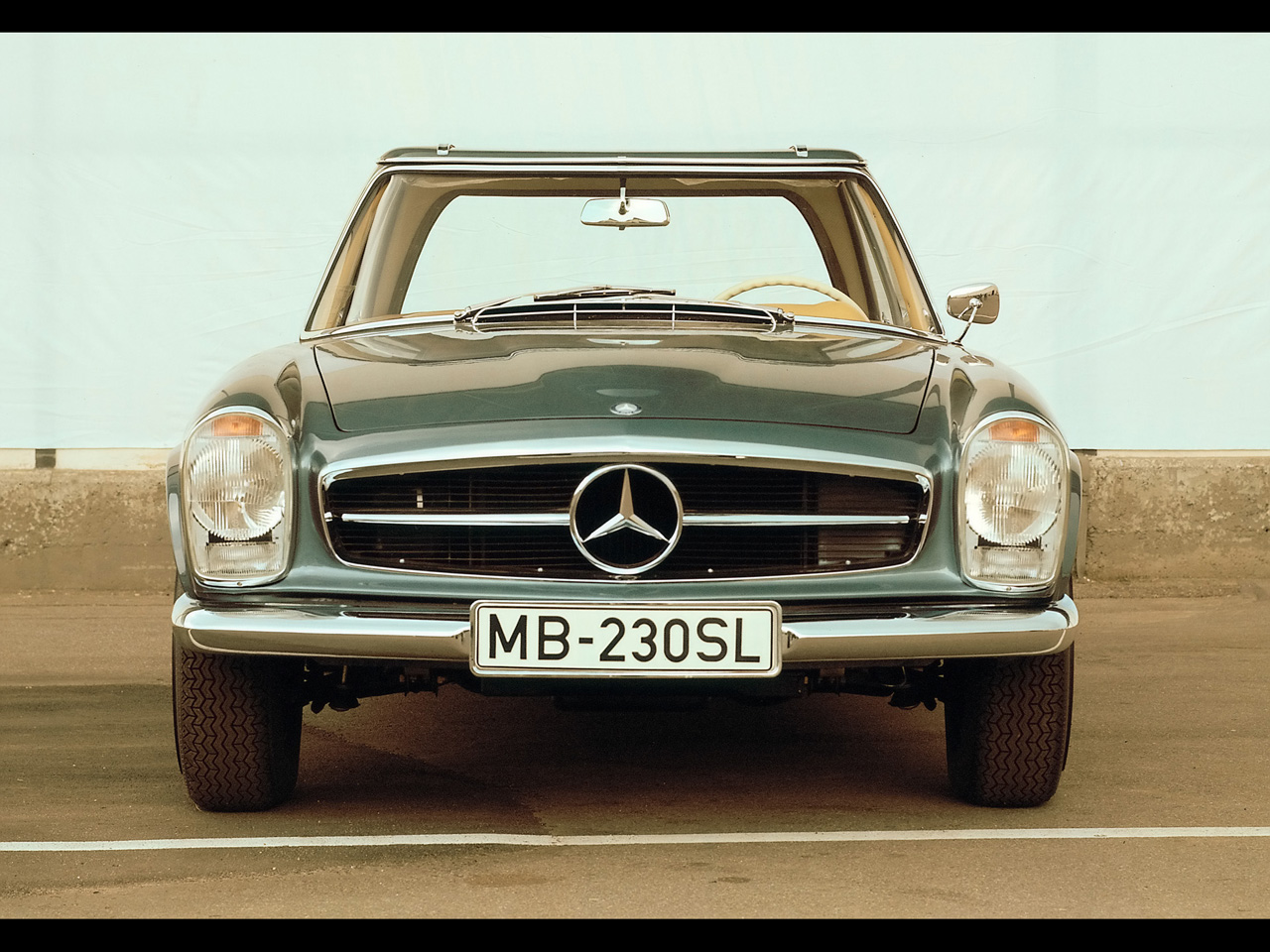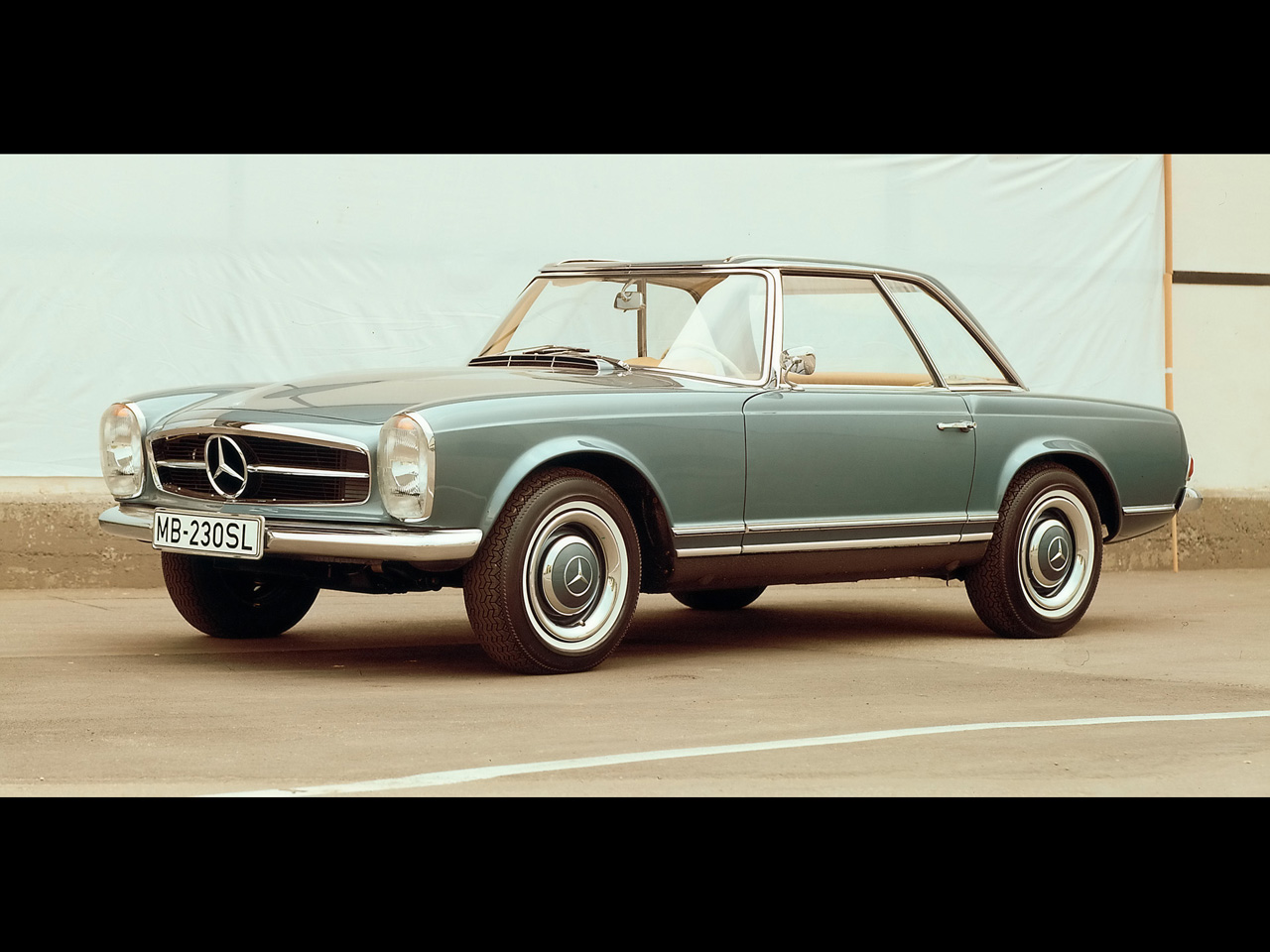1963-1971 Mercedes-Benz W 113 SL Class
|
Price |
-- |
Production |
-- | ||
|
Engine |
-- |
Weight |
-- | ||
|
Aspiration |
-- |
Torque |
-- | ||
|
HP |
-- |
HP/Weight |
-- | ||
|
HP/Liter |
-- |
1/4 mile |
-- | ||
|
0-62 mph |
-- |
Top Speed |
-- |
(from Mercedes-Benz Press Release) The "Pagoda": the W 113 series (1963 to 1971)
-- A comfortable
two-seater touring car featuring high performance and optimum
handling safety
-- Its characteristic roof shape gives it its nickname
-- First SL with a safety body à la Béla Barényi
The Geneva Motor Show of March 1963 was the scene of a remarkable and well-regarded premiere: Daimler-Benz presented the Mercedes-Benz 230 SL, a new sports car to replace two models of the previous sales range. Its two predecessors, the 190 SL and 300 SL, were extremely popular and successful from the start. The 300 SL in particular was already a living legend. However, despite the family likeness the two embodied fundamentally different vehicle concepts, and that, in particular, did not make the start of the 230 SL any easier.
The new model took a middle course, so to speak, between the concepts of the 190 SL and 300 SL: the 230 SL, internally also designated the W 113 series, was neither an uncompromisingly hard roadster nor a meek boulevard sports car, but rather a comfortable two-seater touring car featuring high performance and optimum driving safety. It was available from summer 1963 in three versions: an open-top car with a folding soft top that could be operated with the greatest of ease – that in itself was a minor sensation; an open-top version with hardtop, and finally as hardtop coupé. The hardtop coupé had no soft top and soft-top compartment, but in exchange more room for luggage. All three versions could be driven with the top open. As an optional extra a rear transverse seat was available, as in the 190 SL.
The exterior of the 230 SL is characterised by clear, straight lines and the unmistakable SL face including the large, centrally positioned Mercedes star. The bonnet has a slight additional bulge in the middle to provide space for the vertically installed six-cylinder engine. The boot is generously dimensioned. The hardtop with high windows and a roof borne up only by slim pillars conveys an impression of lightness which simply does not match the stereotype of a sports car. With its inwardly directed curvature it reminds one of Far Eastern temples, and straightaway the car had a nickname before it really even hit the road: "Pagoda". In addition, because of its shape the hardtop made it easier to get in and out of the car.
Apart from the wheelbase – the magic number of 2400 millimetres was taken unchanged from the 190 SL and 300 SL models – the new SL had practically nothing in common with its two predecessors. All the same, the W 113 series was not an entirely new design since its technical concept largely conformed to that of the 220 SE (W 111/3); as two-seater cabriolet of the "Tailfin" series the SL used that series' frame-floor assembly, albeit shortened and reinforced, including front and rear wheel suspension.
In addition to the standard-fit four-speed manual transmission, for the first time in an SL a four-speed automatic transmission was available as an optional extra. A five-speed manual transmission procured from Zahnradfabrik Friedrichshafen (ZF) was added as third variant in May 1966.
Safety is the new word
The "Pagoda" is the first SL in which speed combined with safety. Since its basis is the floor unit of the famed "Tailfin", the world's first saloon with a safety body, this SL also had a stiff passenger cell and crumple zones in the form of easily deformable front and rear segments. This design goes back to engineer Béla Barényi, who devised many of the safety features in cars of the Mercedes-Benz brand. As in the Saloon the interior was designed so as to reduce injury hazards in accidents, meaning that there were no hard corners and edges. As in the previous model, seat belts were available as an optional extra. The steering gear was moved from the crash-imperilled front section to the firewall; the steering column yields to axial compression and additionally features a joint that prevents the feared lance effect in an accident. In 1967 the telescoping safety steering column and the impact absorber in the steering wheel were added.
Chassis, engine and transmission
The chassis, adopted from the 220 SE Saloon, is tuned to the requirements of the sporty car, offering recirculating ball steering, a dual-circuit brake system and disc brakes on the front wheels. The suspension is taut, but for a sports car almost atypically comfortable. Damping was provided by gas-filled shock absorbers, and for the first time an SL rode on radial ply tyres.
The six-cylinder, which also came from the Saloon, underwent several major changes, the most important of which was the transition from a two-plunger injection pump to a six-plunger unit. This made it possible to "shoot" the fuel directly through the preheated intake port and the opened intake valves into the combustion chamber, and not just into the intake pipe, as before. The M 127 II engine, its bore enlarged to give it a displacement of 2.3 litres, thus developed 110 kW at 5500 rpm and delivered torque of 20 mkg (196 Newton metres) at 4200 rpm. Designed very sportily, this drive unit for the SL needed a lot of revving and did not take kindly to underrevving.
The four-speed transmission, likewise from the saloon construction kit, was designed with a slightly lower ratio in 1st gear to achieve sportier acceleration. It sprinted from 0 to 100 km/h in 9.7 seconds. The top speed of the fabric-roofed 230 SL was 200 km/h. The variant with the optional automatic transmission reached a top speed of 195 km/h. In the eyes of sports car purists the automatic is almost immoral. But history teaches us a different lesson: by the time the "Pagoda" was discontinued the automatic transmission's share was around 77 percent. It was much the same with the power steering that was also available at extra cost. The W 113 series was a pioneer also on that score: all subsequent SL models always pair exceptionally good performance with highest levels of comfort. The respectable number of 19,831 units of the 230 SL were built.
Successors with higher displacements
On 27 February 1967 the Mercedes-Benz 250 SL was presented to the public. It replaced the 230 SL that had been produced for four years. On the outside the new car, series production of which already had begun in December 1966, could not be distinguished from its predecessor. The changes concerned mainly the engine and the brake system. Both were taken, slightly modified, from the 250 SE (W 108 III). The M 129 III engine, its displacement enlarged by 200 cubic centimetres, had the same output as the 230 SL, 110 kW at 5500 rpm, but ten percent more torque and a flatter torque curve. It was now provided with seven crankshaft bearings for smoother operation, and with an oil/water heat exchanger as well; only the future 280 SL would get an air/oil cooler. The 250 SL thus was appreciably more flexible in operation, but did not quite reach the previous model's top speed owing to its higher weight. The 250 SL's top speed with four-speed manual transmission was 195 km/h or 200 km/h depending on final drive ratio (standard: 1:3.92; optional: 1:3.69; automatic transmission: 190 km/h or 195 km/h). With five-speed manual transmission it was available in only one variant (1:4.08), which then got 200 km/h.
The changes to the brake system included disc brakes on the rear wheels as well, larger brake discs at the front, and the fitting of a brake power regulator to prevent overbraking by the rear wheels. As an optional extra a differential lock now was available. A fuel tank capacity of 82 litres instead of the previous 65 permitted an extended cruising range. In addition to the three body versions known from the 230 SL, the 250 SL was available as an optional extra in a fourth version, a Coupé with rear seat bench, which was shown for the first time in March 1967 at the Geneva Motor Show. In this so-called California version, the necessary space for the rear bench seat had been obtained by eliminating soft top and soft-top compartment. Since the soft top could not be retrofitted, this variant promised unspoilt driving pleasure only in dry regions or with mounted coupé roof.
Less than a year since the presentation of the 250 SL, after 5196 units had been built it was replaced by the 280 SL. Apart from the model plate it could only be distinguished on the outside from the two preceding models by the changed wheel embellishers.
In the wake of the market launch of the intermediate range models of the 114/115 series, not only the luxury-class Saloons, Coupés and Cabriolets, but also the SL got a 2.8-litre engine. Thanks to a camshaft with changed valve timing, the variant of the M 130 engine used in the 280 SL mobilised 7.4 kW more than the base version of the 280 SE, developing 125 kW at 5750 rpm. Compared with the 250 SL the power had been increased by around 15 kW and torque by ten percent. For the first time the radiator fan was fitted with a viscous coupling which limited the rotational speed. The 0 to 100 km/h was in the vicinity of nine seconds and the top speed again came up to the level of the 230 SL, i.e., 200 km/h in the fabric-topped version. Its suspension, designed for further enhanced comfort, was softer. The service intervals were 10,000 kilometres instead of 3000.
23,885 units of the fast and reliable Mercedes-Benz 280 SL rolled off the assembly line. All in all, from 1963 to 1971 a total of 48,912 "Pagodas" were built – remarkable for a sports car with such high standards. Today its high overall quality, its elegance and its clear lines make the W 113 series a coveted item among restorers and collectors.
The W 113 series in the press
The motor magazine auto
motor und sport, Germany, No. 6, 1963, characterised the
Mercedes-Benz 230 SL: "A sports car that does 200 km/h, goes from 0
to 100 km/h in less than ten seconds, yet has the smooth engine
running characteristics and comfort of a touring car."
A detailed test report in auto motor und sport, Germany, No. 21,
1963, added: "The upshot: the 230 SL is one of the most refined
sports cars ever. All the same it deserves to be numbered among the
truly sporty vehicles because it not only delivers sporty
performance, but is as compact and safe-handling as should be
expected of a sports car. ... And finally, you can push the 230 SL
at a very fast pace if you wish, but you can also maintain the
slowcoach tempo that traffic conditions so frequently force upon
us."



